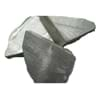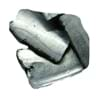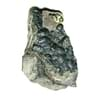Toxic Metals
|
Melting Point
1,554.90 °C Group Number
10 Period Number
5 Atomic Number
46 Boiling Point
2,963.00 °C Crystal Structure
Face Centered Cubic (FCC) |
||
|
Melting Point
97.72 °C Group Number
1 Period Number
3 Atomic Number
11 Boiling Point
883.00 °C Crystal Structure
Body Centered Cubic (BCC) |
||
|
Melting Point
Not Available Group Number
12 Period Number
6 Atomic Number
80 Boiling Point
356.58 °C Crystal Structure
Rhombohedral (RHO) |
||
|
Melting Point
63.65 °C Group Number
1 Period Number
4 Atomic Number
19 Boiling Point
774.00 °C Crystal Structure
Body Centered Cubic (BCC) |
||
|
Melting Point
1,132.00 °C Group Number
0 Period Number
7 Atomic Number
92 Boiling Point
3,818.00 °C Crystal Structure
Orthorhombic (ORTH) |
||
|
Melting Point
327.50 °C Group Number
14 Period Number
6 Atomic Number
82 Boiling Point
1,740.00 °C Crystal Structure
Face Centered Cubic (FCC) |
||
|
Page 1
of
2
Click Here to View All
|
Toxic Metals List
Looking for Toxic Metals List? then you are at the right place. We provide all Toxic Metals at a glance, through which you can navigate to their different parameter/properties like physical and chemical properties, mechanical stress/hardness, thermodynamics, magnetic and optical characteristics and many more! Want to know more about Toxic Metals and their properties? Toxic metals have a tendency to accumulate in the body over a period, disturbing the fundamental mechanism of body organs. Although their traces are present in a healthy body, their gradual accumulation or excess intake may be considerably poisonous or fatal. According to the study of chemical elements, all elements are mainly classified into three main types, i.e. metals, nonmetals and metalloids. Metals are generally found in the ores of other elements or minerals and exhibit hard and solid metallic luster. At metals.comparenature.com, apart from studying just a single metal, we also serves a facility of comparative analysis of metals based on their different properties & characteristics!
Toxic Metals Properties
Toxic Metals properties give you a broad overview of these metals from multiple angels. Moreover, enthusiasts are also catered with the detailed breakdown of the atomic, optical and chemical behaviour of the metals. Supplementary facts like side effects & benefits of these metals, their abundance in earth's crust, their presence in the human body, etc. are also furnished for knowledge seekers. All the properties of these metal such as their physical, chemical, mechanical, thermal, optical, biological, magnetic, electrical are explained in brief with the help of relevant specifications.
Periodic table of Toxic Metals illustrates the significance of the position of Toxic Metals in the modern periodic table. Since its inception, the periodic table has evolved time and again, due to the discoveries of certain new metals and their properties. The arrangement of metals is organized with a view to making their identification simpler! This arrangement is in the form of horizontal rows (periods) and columns(groups), which are classified by specific criteria. Atomic number is prominent among these criteria. All metals have unique characteristics and hence they have different atomic numbers and other properties. In the periodic table, all the metals are categorized under different categories like the alkali metals, alkaline earth metals, transition, post-transition metals, lanthanide series metals and actinide series metals.
|
||
|
||
|





